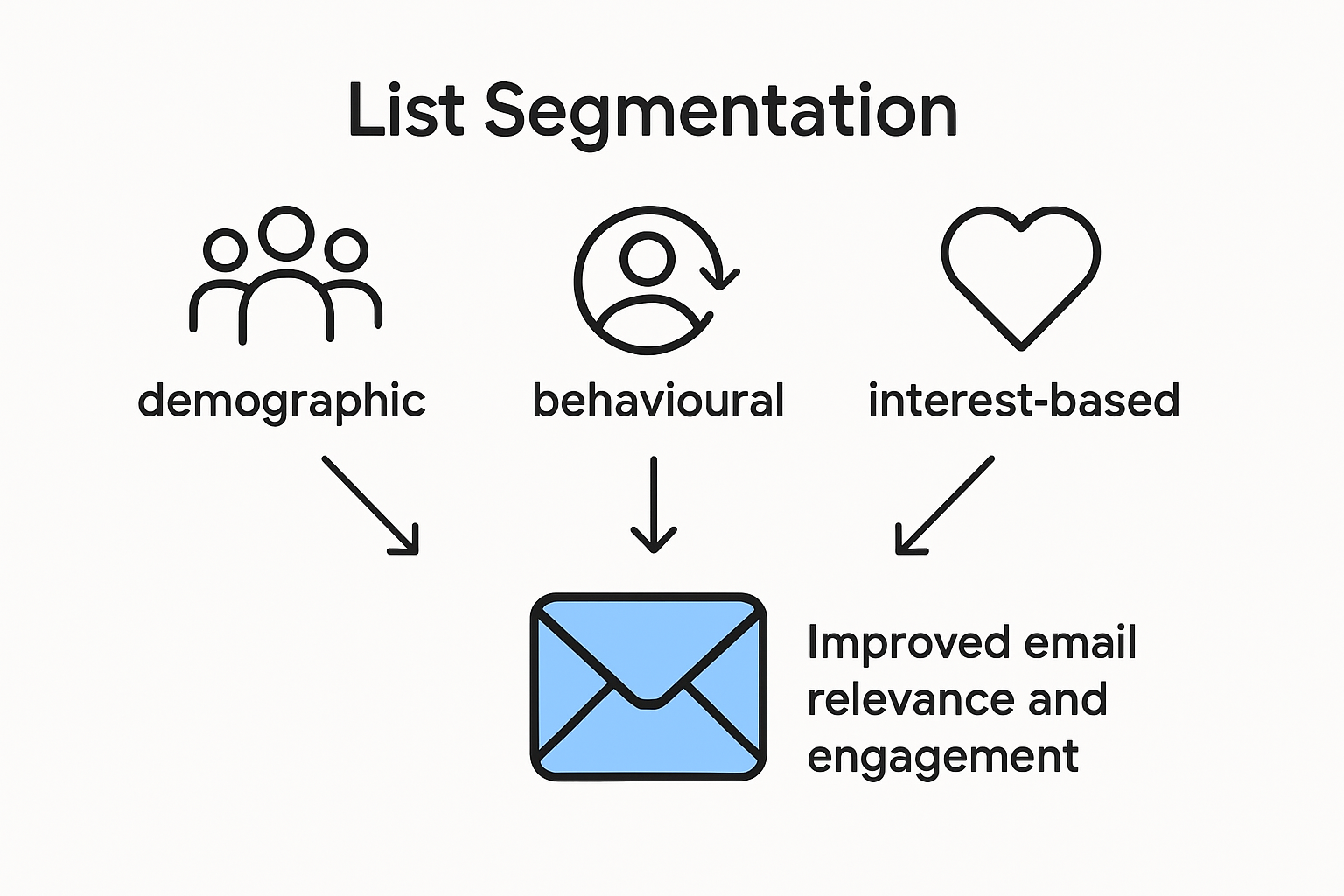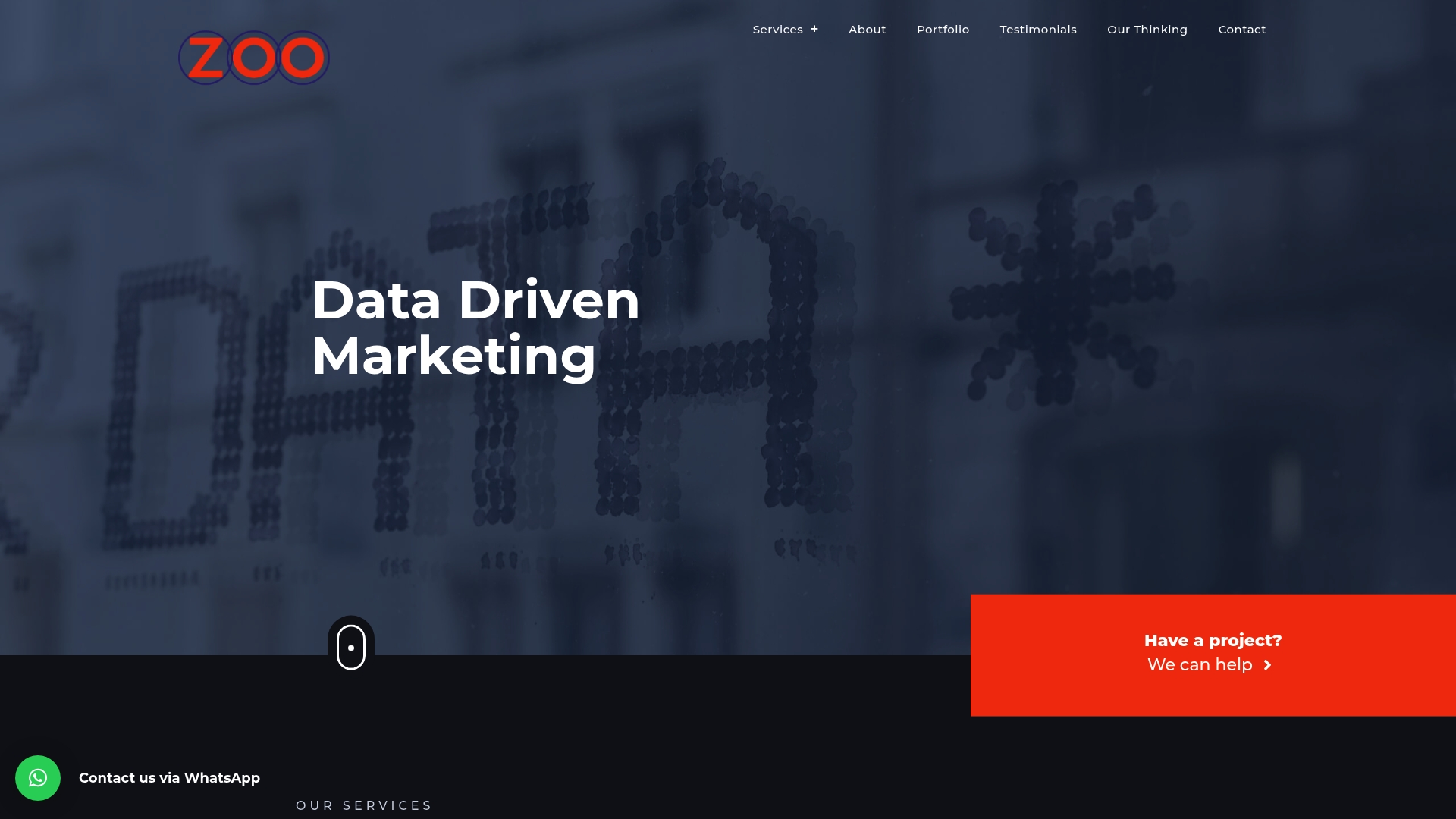Email marketing still gets people talking in 2025. With successful campaigns seeing click-through rates as high as 25 percent for top brands, you’d think it’s all just about getting more eyes on your messages. But that’s not where most businesses trip up. The biggest wins come from the basics: knowing your list, speaking directly to your people, and making every send count. Small changes can mean huge results.
Table of Contents
- [What Are Email Marketing Fundamentals?
Email marketing fundamentals represent the core strategies and techniques businesses use to communicate effectively with their audience through digital messaging. Understanding these fundamentals is crucial for creating meaningful connections and driving business growth in the digital landscape.
The Essential Components of Email Marketing
At its core, email marketing is more than just sending messages. It involves a strategic approach to reaching potential and existing customers directly in their personal digital space. Research from the Email Marketing Institute highlights that successful email marketing requires a combination of targeted content, precise audience segmentation, and consistent communication.
The fundamental elements include building a quality email list, crafting compelling subject lines, designing engaging content, and understanding the technical aspects of email delivery. Businesses must focus on creating value for recipients rather than simply pushing sales messages. This means developing content that solves problems, provides insights, or offers genuine benefits to the target audience.
Strategic Approaches to Email Communication
According to comprehensive digital marketing guides, effective email marketing fundamentals involve several critical steps. These include:
- Audience Targeting: Identifying and segmenting your email list to ensure relevant communication
- Content Quality: Creating messages that provide real value to recipients
- Timing and Frequency: Understanding when and how often to communicate with your audience
- Performance Measurement: Tracking key metrics like open rates, click-through rates, and conversion rates
Businesses must recognize that email marketing is not a one-size-fits-all strategy. Each campaign requires careful planning, read more about effective email strategies to understand the nuanced approach needed for success. The goal is to build relationships, not just send mass communications.
Technical considerations play a significant role in email marketing fundamentals. This includes understanding email deliverability, managing subscriber lists, implementing proper consent mechanisms, and ensuring compliance with data protection regulations. Successful email marketing requires a blend of creative communication and technical precision.
Ultimately, email marketing fundamentals are about creating meaningful connections. It’s a powerful tool that allows businesses to communicate directly with their audience, providing personalized content that resonates with individual needs and interests. By mastering these fundamental principles, businesses can transform email from a simple communication channel into a strategic marketing asset that drives engagement and growth.](#what-are-email-marketing-fundamentalsnnemail-marketing-fundamentals-represent-the-core-strategies-and-techniques-businesses-use-to-communicate-effectively-with-their-audience-through-digital-messaging-understanding-these-fundamentals-is-crucial-for-creating-meaningful-connections-and-driving-business-growth-in-the-digital-landscapenn-the-essential-components-of-email-marketingnnat-its-core-email-marketing-is-more-than-just-sending-messages-it-involves-a-strategic-approach-to-reaching-potential-and-existing-customers-directly-in-their-personal-digital-space-research-from-the-email-marketing-institutehttpswwwemarketinginstituteorgfree-ebooksemail-marketing-for-beginnerschapter-2-basics-of-email-marketing-highlights-that-successful-email-marketing-requires-a-combination-of-targeted-content-precise-audience-segmentation-and-consistent-communicationnnthe-fundamental-elements-include-building-a-quality-email-list-crafting-compelling-subject-lines-designing-engaging-content-and-understanding-the-technical-aspects-of-email-delivery-businesses-must-focus-on-creating-value-for-recipients-rather-than-simply-pushing-sales-messages-this-means-developing-content-that-solves-problems-provides-insights-or-offers-genuine-benefits-to-the-target-audiencenn-strategic-approaches-to-email-communicationnnaccording-to-comprehensive-digital-marketing-guideshttpsopentextbccafoundationsdigitalmarketingchapteremail-marketing-effective-email-marketing-fundamentals-involve-several-critical-steps-these-includenn-audience-targeting-identifying-and-segmenting-your-email-list-to-ensure-relevant-communicationn-content-quality-creating-messages-that-provide-real-value-to-recipientsn-timing-and-frequency-understanding-when-and-how-often-to-communicate-with-your-audiencen-performance-measurement-tracking-key-metrics-like-open-rates-click-through-rates-and-conversion-ratesnnbusinesses-must-recognize-that-email-marketing-is-not-a-one-size-fits-all-strategy-each-campaign-requires-careful-planning-read-more-about-effective-email-strategieshttpszoodigitalcozabest-practices-for-email-marketing-2025-small-business-to-understand-the-nuanced-approach-needed-for-success-the-goal-is-to-build-relationships-not-just-send-mass-communicationsnntechnical-considerations-play-a-significant-role-in-email-marketing-fundamentals-this-includes-understanding-email-deliverability-managing-subscriber-lists-implementing-proper-consent-mechanisms-and-ensuring-compliance-with-data-protection-regulations-successful-email-marketing-requires-a-blend-of-creative-communication-and-technical-precisionnnultimately-email-marketing-fundamentals-are-about-creating-meaningful-connections-its-a-powerful-tool-that-allows-businesses-to-communicate-directly-with-their-audience-providing-personalized-content-that-resonates-with-individual-needs-and-interests-by-mastering-these-fundamental-principles-businesses-can-transform-email-from-a-simple-communication-channel-into-a-strategic-marketing-asset-that-drives-engagement-and-growth)
- Building a Quality Email List for Small Businesses
- Crafting Engaging Email Content That Converts
- Measuring Success and Improving Your Campaigns
Quick Summary
| Takeaway | Explanation |
|---|---|
| Build and segment your email list | Focus on creating a quality list with permission-based collection and segment subscribers by demographics or interests for relevant communication. |
| Create engaging and relevant content | Develop email messages that provide value and solve problems, using compelling subject lines and strong calls-to-action to motivate recipients. |
| Measure key performance metrics | Track essential metrics like click-through rates, conversion rates, and unsubscribe rates to assess and improve campaign effectiveness. |
| Opt for continuous improvement through testing | Regularly perform A/B testing to enhance email elements like subject lines and content formats to foster better engagement. |
| Ensure compliance and technical precision | Manage subscriber lists responsibly, ensuring consent and compliance with data protection regulations while optimizing email delivery and engagement. |
What Are Email Marketing Fundamentals?
Email marketing fundamentals represent the core strategies and techniques businesses use to communicate effectively with their audience through digital messaging. Understanding these fundamentals is crucial for creating meaningful connections and driving business growth in the digital landscape.
The Essential Components of Email Marketing
At its core, email marketing is more than just sending messages. It involves a strategic approach to reaching potential and existing customers directly in their personal digital space. Research from the Email Marketing Institute highlights that successful email marketing requires a combination of targeted content, precise audience segmentation, and consistent communication.
The fundamental elements include building a quality email list, crafting compelling subject lines, designing engaging content, and understanding the technical aspects of email delivery. Businesses must focus on creating value for recipients rather than simply pushing sales messages. This means developing content that solves problems, provides insights, or offers genuine benefits to the target audience.
Strategic Approaches to Email Communication
According to comprehensive digital marketing guides, effective email marketing fundamentals involve several critical steps. These include:
- Audience Targeting: Identifying and segmenting your email list to ensure relevant communication
- Content Quality: Creating messages that provide real value to recipients
- Timing and Frequency: Understanding when and how often to communicate with your audience
- Performance Measurement: Tracking key metrics like open rates, click-through rates, and conversion rates
Businesses must recognize that email marketing is not a one-size-fits-all strategy. Each campaign requires careful planning, read more about effective email strategies to understand the nuanced approach needed for success. The goal is to build relationships, not just send mass communications.
Technical considerations play a significant role in email marketing fundamentals. This includes understanding email deliverability, managing subscriber lists, implementing proper consent mechanisms, and ensuring compliance with data protection regulations. Successful email marketing requires a blend of creative communication and technical precision.
Ultimately, email marketing fundamentals are about creating meaningful connections. It’s a powerful tool that allows businesses to communicate directly with their audience, providing personalized content that resonates with individual needs and interests. By mastering these fundamental principles, businesses can transform email from a simple communication channel into a strategic marketing asset that drives engagement and growth.
Here is a table summarising the essential components and strategic approaches of email marketing fundamentals for easier reference:
| Component/Approach | Description |
|---|---|
| Quality Email List | Build and manage a list with explicit permission and strategic segmentation |
| Compelling Subject Lines | Craft attention-grabbing subject lines to boost open rates |
| Engaging Content | Develop valuable, problem-solving, and relevant content for recipients |
| Audience Targeting | Identify and segment subscribers for personalised communication |
| Timing and Frequency | Determine optimal times and frequency for sending emails |
| Performance Measurement | Track and analyse key metrics: open rate, click-through rate, conversion rate |
| Technical & Compliance Aspects | Manage deliverability, consent, and adhere to data protection regulations |
Building a Quality Email List for Small Businesses
Building a quality email list represents a critical foundation for successful digital marketing strategies. Small businesses must approach email list development with strategic precision, focusing on attracting genuinely interested subscribers who will engage with their content.
Permission-Based List Building Strategies
According to the U.S. Small Business Administration, obtaining explicit permission from potential subscribers is fundamental to creating an effective email list. This means implementing transparent and ethical methods for collecting email addresses. Small businesses should never purchase email lists or add contacts without their consent, as this can damage reputation and violate digital marketing regulations.
Effective list-building techniques include creating compelling opt-in forms on websites, offering valuable incentives for subscription, and clearly communicating the benefits of joining the email list. The Rhode Island Small Business Development Center recommends providing exclusive content, discounts, or special offers as motivation for potential subscribers to share their contact information.
Segmentation and Targeting Techniques

Research from the U.S. Chamber of Commerce emphasizes the importance of list segmentation. By categorizing subscribers based on specific characteristics such as demographics, purchasing behavior, or engagement levels, businesses can create more targeted and relevant email communications. This approach significantly improves open rates, click-through rates, and overall email marketing effectiveness.
Segmentation strategies might include:
- Demographic Grouping: Organizing subscribers by age, location, or profession
- Behavioral Tracking: Categorizing subscribers based on previous interactions with your business
- Interest-Based Segmentation: Dividing lists according to specific product or service preferences
Learn more about advanced targeting techniques to refine your email marketing approach and maximize audience engagement.
Maintaining list quality requires ongoing management. This involves regularly cleaning your email list by removing inactive subscribers, ensuring email addresses remain valid, and providing easy unsubscribe options. Businesses should view their email list as a dynamic asset that requires consistent nurturing and optimization.
Technical considerations are equally important. Implementing robust email verification processes, using reputable email service providers, and maintaining compliance with data protection regulations are crucial steps in building a high-quality email list. Small businesses must invest time in understanding these technical aspects to create a reliable and effective email marketing foundation.
Ultimately, a quality email list is not about quantity but about cultivating a genuine connection with potential and existing customers. By focusing on permission-based collection, strategic segmentation, and continuous list management, small businesses can transform their email marketing from a simple communication tool into a powerful engagement platform that drives meaningful business growth.
Below is a table to help you compare different segmentation strategies you can apply to your email list.
| Segmentation Type | Basis | Example Criteria |
|---|---|---|
| Demographic Grouping | Age, location, profession | “Subscribers aged 18–35 in Cape Town” |
| Behavioural Tracking | Past interactions, engagement | “Opened last 3 campaigns but didn’t click” |
| Interest-Based | Product/service preferences | “Signed up for news on laptops only” |
Crafting Engaging Email Content That Converts
Crafting engaging email content represents a critical skill for businesses seeking to transform digital communication into meaningful customer interactions. Successful email marketing goes beyond simply sending messages it requires creating content that resonates, provides value, and motivates recipients to take action.
Understanding Email Content Fundamentals
According to the University of Wisconsin-Madison, effective email content starts with understanding core principles of communication. This means developing messages that are honest, credible, and immediately valuable to the recipient. Every email should answer a fundamental question for the reader: “What’s in it for me?”
Successful email content requires a strategic approach. This involves crafting compelling subject lines that capture attention, writing concise and clear body text, and creating a strong call-to-action that guides readers toward the desired outcome. The goal is not just to inform but to engage and inspire action.
Strategic Content Design and Optimization
Email content design plays a crucial role in conversion. Visual elements, formatting, and layout can significantly impact how recipients interact with your message. Key strategies include:
- Clarity and Brevity: Write concise, easy-to-understand messages
- Visual Hierarchy: Use formatting to guide reader attention
- Personalization: Tailor content to specific audience segments
Discover advanced content optimization techniques that can transform your email marketing approach.
Personalization extends beyond simply including a recipient’s name. It involves understanding customer preferences, behaviors, and pain points. By segmenting your audience and creating targeted content, businesses can dramatically improve engagement rates. This might mean developing different email versions for various customer groups or creating content that speaks directly to specific interests.
Technical considerations are equally important. Ensure your emails are mobile-responsive, load quickly, and display correctly across different email clients and devices. Include alt text for images, use a clean and readable font, and maintain a balanced text-to-image ratio.
The art of conversion lies in creating a seamless narrative that guides readers from initial interest to taking action. This requires a clear and compelling call-to-action (CTA) that stands out visually and communicates exactly what you want the recipient to do. Whether it’s making a purchase, scheduling a consultation, or downloading a resource, your CTA should be direct, action-oriented, and enticing.
Ultimately, engaging email content is about building relationships. It’s not just about selling but about providing genuine value, solving problems, and creating meaningful connections with your audience. By focusing on quality, relevance, and strategic design, businesses can transform email from a simple communication tool into a powerful marketing asset that drives real business growth.
Measuring Success and Improving Your Campaigns
Measuring the success of email marketing campaigns is crucial for small businesses seeking to optimize their digital communication strategies. Understanding and analyzing key performance indicators allows businesses to refine their approach, improve engagement, and ultimately drive better results.
Key Performance Metrics for Email Marketing
According to the University of Colorado, data-driven email marketing requires careful examination of multiple performance indicators. While traditional metrics like open rates have become less reliable due to privacy enhancements, businesses can focus on more robust measures of campaign effectiveness.
The essential metrics that small businesses should track include:
- Click-Through Rate: Measures the percentage of recipients who clicked on links within the email
- Conversion Rate: Tracks the number of recipients who completed a desired action
- Bounce Rate: Indicates the percentage of emails that could not be delivered
- Unsubscribe Rate: Shows how many recipients opt out of future communications
Learn more about advanced marketing analytics to gain deeper insights into your email performance.
Here is a table offering a quick reference to the key metrics used to measure email campaign success.
| Metric | What It Tracks | Why It’s Important |
|---|---|---|
| Click-Through Rate | Recipients who click links in the email | Shows effectiveness of content and CTAs |
| Conversion Rate | Recipients who complete a desired action | Assesses ROI and campaign success |
| Bounce Rate | Emails not delivered to recipient inbox | Indicates list quality and deliverability |
| Unsubscribe Rate | Recipients opting out of communication | Signals relevance and audience satisfaction |
Interpreting and Acting on Campaign Data
Research from The Hartford provides industry benchmarks that help businesses contextualize their performance. Typically, email open rates range in the low to mid-20% range, but these numbers can vary significantly across different industries and audience segments.
Interpreting metrics goes beyond simply looking at numbers. Businesses must understand the story behind the data. A low click-through rate might indicate issues with content relevance, subject line effectiveness, or audience targeting. Conversely, high engagement rates suggest that the current strategy is resonating with recipients.
Wikipedia’s analysis of email metrics highlights the complexity of measuring email marketing success. Factors like image blocking, privacy settings, and varying email client behaviors can impact traditional measurement approaches. This underscores the importance of using multiple metrics to gain a comprehensive view of campaign performance.
Continuous improvement requires a systematic approach to testing and optimization. A/B testing different elements of your emails can provide valuable insights. This might involve experimenting with subject lines, content formats, send times, or call-to-action designs. By systematically testing and measuring results, businesses can incrementally improve their email marketing effectiveness.
Technical considerations are equally important. Ensure your email tracking tools are properly configured, comply with data protection regulations, and provide accurate, actionable insights. Invest in robust email marketing platforms that offer comprehensive analytics and reporting capabilities.
Ultimately, measuring email marketing success is an ongoing process of learning and adaptation. By staying data-driven, remaining flexible, and continuously refining your approach, small businesses can transform email marketing from a simple communication tool into a powerful strategy for customer engagement and business growth. The key is to view each campaign as an opportunity to learn, improve, and better understand your audience’s needs and preferences.

Frequently Asked Questions
What are the fundamental components of email marketing?
Email marketing fundamentally involves building a quality email list, crafting compelling subject lines, designing engaging content, and understanding the technical aspects of email delivery. It is essential to focus on providing value to recipients rather than simply pushing sales messages.
How can I build a quality email list for my business?
To build a quality email list, implement permission-based strategies such as using opt-in forms on your website, offering valuable incentives for subscriptions, and clearly communicating the benefits of joining your list. Avoid purchasing email lists, as this can damage your reputation.
What metrics should I track to measure the success of my email campaigns?
Key metrics to track include click-through rates, conversion rates, bounce rates, and unsubscribe rates. These metrics help assess the effectiveness of your email content and audience engagement, allowing for data-driven improvements in future campaigns.
How can I create engaging email content that converts?
To create engaging email content, focus on writing clear and concise messages, utilizing compelling subject lines, and including strong calls to action. Tailor your content to specific audience segments to enhance relevance and encourage action.
Ready to Make Your Email Marketing Work Harder for You?
Many business owners know the frustration of sending campaign after campaign and seeing little return. You have read how crucial permission-based lists and targeted content are, and yet, your open rates and conversions just do not reflect your hard work. The pain of wasted time and missed opportunities can leave you feeling stuck, especially with technical issues or poor segmentation holding back your results. This is where expert support can turn the basics into breakthroughs. Discover proven solutions for sustainable growth with our Uncategorized Archives – Zoo Digital resources.

Stop struggling with the same email marketing fundamentals that leave you chasing success. Book a free discovery call on Zoo Digital today and see how our data-driven strategies can help you build a thriving, engaged email list, craft messages that convert, and track every click for real business growth. Take action now for measurable results from your next campaign.
Recommended
- Best Practices for Email Marketing in 2025: Small Business Guide – Zoo Digital
- Digital Marketing for Beginners: 2025 Guide for Small Businesses – Zoo Digital
- How to Build a Marketing Strategy for Small Businesses in 2025 – Zoo Digital
- Digital Marketing Terms Explained for Small Businesses 2025 – Zoo Digital

